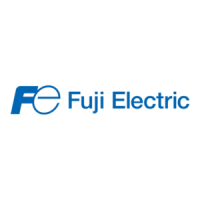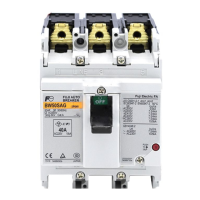Do you have a question about the Fuji Electric EW32SAG and is the answer not in the manual?
Details types of circuit breakers covered: Molded Case and Earth Leakage.
Provides detailed technical data for circuit breakers.
Explains FUJI's commitment to providing comprehensive MCCB models and features.
Describes common low-voltage circuit faults: overcurrent, ground faults, and phase-loss.
Explains protection against overload and short-circuit conditions.
Details protection against phase-loss faults in three-phase circuits.
Covers types of overcurrent tripping: inverse-time delay, instantaneous, and short-time delay.
Details how circuit breakers interrupt short-circuit currents.
Describes performance during overload switching tests.
Covers temperature rise and internal resistance at rated current.
Details switching durability and short-circuit breaking performance.
Covers power frequency and impulse withstand voltage tests.
Provides specifications for handle operation.
Lists key factors to consider when selecting MCCBs for low-voltage circuits.
Explains backup coordination between overcurrent protective devices.
Details coordination between devices for improved power feeding reliability.
Covers protection of wiring against heat generated by overcurrents.
Discusses protection strategies for motor circuits and associated wiring.
Explains selection based on transformer inrush current.
Addresses specific considerations for welder circuits.
Details selection criteria for capacitor circuits.
Covers protection of circuits with semiconductor devices like thyristors.
Recommends combinations for protecting Solid State Contactors (SSCs).
Discusses protection of inverter circuits.
Addresses selection of MCCBs for high-frequency applications.
Explains MCCB usage and selection for DC circuits.
Provides selection guidelines for MCCBs used with UPS systems.
Details MCCB selection for servo amplifier power supply.
Covers grounding methods and ground fault protection strategies.
Lists standard operating conditions for MCCB performance evaluation.
Discusses usage in high-temperature, cold, and high-altitude conditions.
Provides guidelines on proper connection methods and torque.
Explains prevention of tripping due to transient inrush currents.
Identifies common faults and their potential causes during MCCB operation.
Outlines procedures for initial and periodic inspections.
Provides guidelines for MCCB deterioration diagnosis and replacement.
Explains the objective and methods for calculating short-circuit current.
Emphasizes operating within specified environments and reading manuals.
Advises consultation for atomic-energy, aerospace, medical, and traffic control applications.
Requires safety measures for systems affecting human lives or property.
Stresses that wiring should be done by qualified engineers.
Details types of circuit breakers covered: Molded Case and Earth Leakage.
Provides detailed technical data for circuit breakers.
Explains FUJI's commitment to providing comprehensive MCCB models and features.
Describes common low-voltage circuit faults: overcurrent, ground faults, and phase-loss.
Explains protection against overload and short-circuit conditions.
Details protection against phase-loss faults in three-phase circuits.
Covers types of overcurrent tripping: inverse-time delay, instantaneous, and short-time delay.
Details how circuit breakers interrupt short-circuit currents.
Describes performance during overload switching tests.
Covers temperature rise and internal resistance at rated current.
Details switching durability and short-circuit breaking performance.
Covers power frequency and impulse withstand voltage tests.
Provides specifications for handle operation.
Lists key factors to consider when selecting MCCBs for low-voltage circuits.
Explains backup coordination between overcurrent protective devices.
Details coordination between devices for improved power feeding reliability.
Covers protection of wiring against heat generated by overcurrents.
Discusses protection strategies for motor circuits and associated wiring.
Explains selection based on transformer inrush current.
Addresses specific considerations for welder circuits.
Details selection criteria for capacitor circuits.
Covers protection of circuits with semiconductor devices like thyristors.
Recommends combinations for protecting Solid State Contactors (SSCs).
Discusses protection of inverter circuits.
Addresses selection of MCCBs for high-frequency applications.
Explains MCCB usage and selection for DC circuits.
Provides selection guidelines for MCCBs used with UPS systems.
Details MCCB selection for servo amplifier power supply.
Covers grounding methods and ground fault protection strategies.
Lists standard operating conditions for MCCB performance evaluation.
Discusses usage in high-temperature, cold, and high-altitude conditions.
Provides guidelines on proper connection methods and torque.
Explains prevention of tripping due to transient inrush currents.
Identifies common faults and their potential causes during MCCB operation.
Outlines procedures for initial and periodic inspections.
Provides guidelines for MCCB deterioration diagnosis and replacement.
Explains the objective and methods for calculating short-circuit current.
Emphasizes operating within specified environments and reading manuals.
Advises consultation for atomic-energy, aerospace, medical, and traffic control applications.
Requires safety measures for systems affecting human lives or property.
Stresses that wiring should be done by qualified engineers.
| Brand | Fuji Electric |
|---|---|
| Model | EW32SAG |
| Category | Circuit breakers |
| Language | English |










